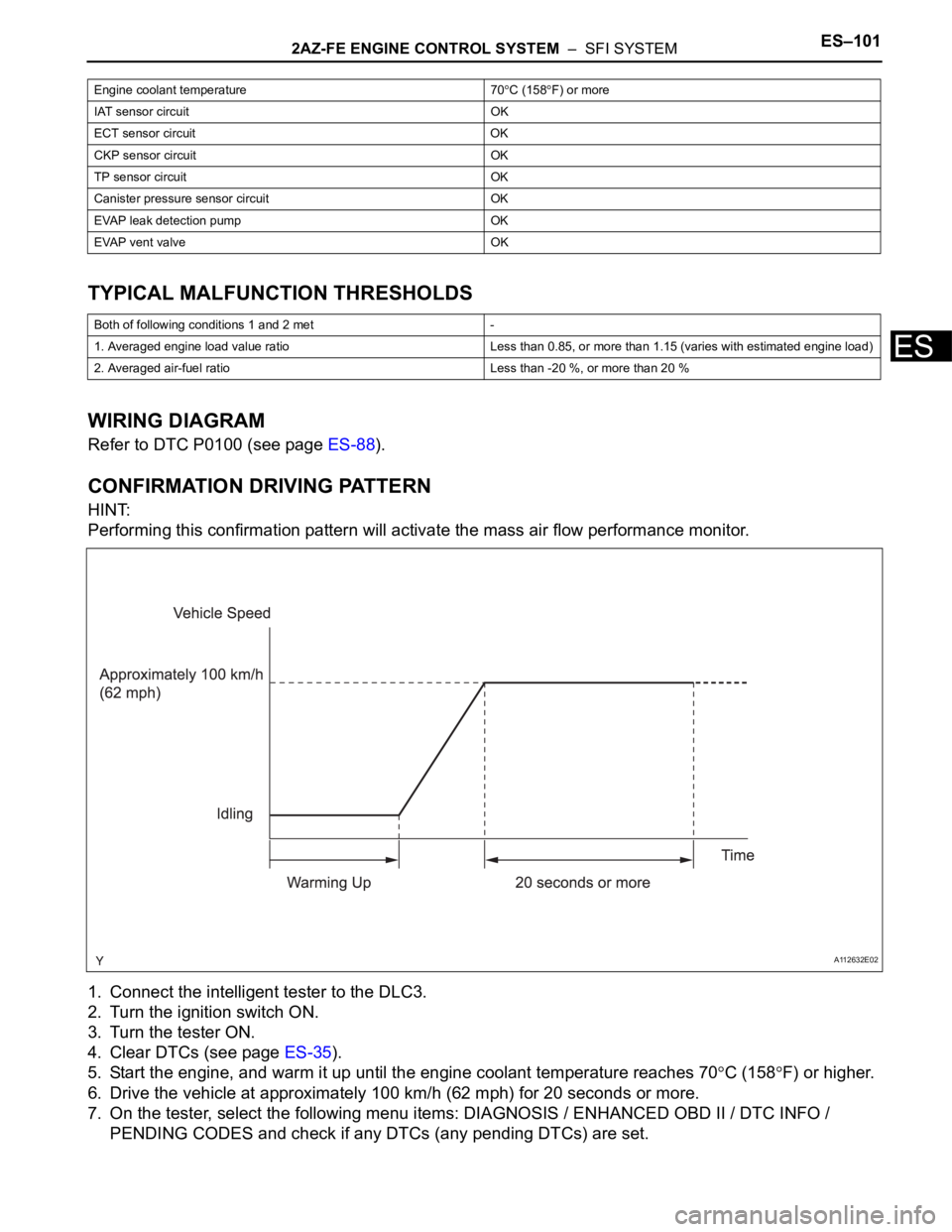Page 1988 of 2000

ES–1002AZ-FE ENGINE CONTROL SYSTEM – SFI SYSTEM
ES
DESCRIPTION
Refer to DTC P0100 (see page ES-86).
MONITOR DESCRIPTION
The MAF meter is a sensor that measures the amount of air flowing through the throttle valve. The ECM
uses this information to determine the fuel injection time and to provide an appropriate air-fuel ratio. Inside
the MAF meter, there is a heated platinum wire which is exposed to the flow of intake air. By applying a
specific electrical current to the wire, the ECM heats it to a specific temperature. The flow of incoming air
cools both the wire and an internal thermistor, affecting their resistance. To maintain a constant current
value, the ECM varies the voltage applied to these components of the MAF meter. The voltage level is
proportional to the airflow through the sensor, and the ECM uses it to calculate the intake air volume.
The ECM monitors the average engine load value ratio to check the MAF meter for malfunctions. The
average engine load value ratio is obtained by comparing the average engine load calculated from the
MAF meter output to the average engine load estimated from the driving conditions, such as the engine
speed and the throttle opening angle. If the average engine load value ratio is below the threshold value,
the ECM determines that the intake air volume is low, and if the average engine load value ratio is above
the threshold value, the ECM determines that the intake air volume is high.
If this is detected in 2 consecutive driving cycles, the MIL is illuminated and a DTC is set.
MONITOR STRATEGY
TYPICAL ENABLING CONDITIONS
DTC P0101Mass Air Flow Circuit Range / Performance
Problem
DTC No. DTC Detection Conditions Trouble Areas
P0101Conditions (a), (b), (c), (d) and (e) continue for more than 10
seconds (2 trip detection logic):
(a) Engine running
(b) Engine coolant temperature 70
C (158F) or higher
(c) Throttle Position (TP) sensor voltage 0.24 V or more
(d) Average engine load value ratio less than 0.85, or more
than 1.15 (varies with estimated engine load)
Average engine load value ratio = Average engine load based
on MAF meter output / Average engine load estimated from
driving conditions
(e) Average air-fuel ratio less than -20 %, or more than 20 %• Mass Air Flow (MAF) meter
• Air induction system
• PCV hose connections
Related DTCs P0101: Mass air flow meter rationality
Required Sensors/Components (Main) Mass air flow meter
Required Sensors/Components (Related)Crankshaft Position (CKP) sensor, Engine Coolant Temperature
(ECT) sensor and Throttle Position (TP) sensor
Frequency of Operation Continuous
Duration 10 seconds
MIL Operation 2 driving cycles
Sequence of Operation None
Monitor runs whenever following DTCs not presentP0115 - P0118 (ECT sensor)
P0120 - P0223, P2135 (TP sensor)
P0125 (Insufficient ECT for closed loop)
P0335 (CKP sensor)
P0340 (CMP sensor)
Throttle position (TP sensor voltage) 0.24 V or more
Engine Running
Battery voltage 10.5 V or more
Page 1989 of 2000

2AZ-FE ENGINE CONTROL SYSTEM – SFI SYSTEMES–101
ES
TYPICAL MALFUNCTION THRESHOLDS
WIRING DIAGRAM
Refer to DTC P0100 (see page ES-88).
CONFIRMATION DRIVING PATTERN
HINT:
Performing this confirmation pattern will activate the mass air flow performance monitor.
1. Connect the intelligent tester to the DLC3.
2. Turn the ignition switch ON.
3. Turn the tester ON.
4. Clear DTCs (see page ES-35).
5. Start the engine, and warm it up until the engine coolant temperature reaches 70
C (158F) or higher.
6. Drive the vehicle at approximately 100 km/h (62 mph) for 20 seconds or more.
7. On the tester, select the following menu items: DIAGNOSIS / ENHANCED OBD II / DTC INFO /
PENDING CODES and check if any DTCs (any pending DTCs) are set.
Engine coolant temperature 70C (158F) or more
IAT sensor circuit OK
ECT sensor circuit OK
CKP sensor circuit OK
TP sensor circuit OK
Canister pressure sensor circuit OK
EVAP leak detection pump OK
EVAP vent valve OK
Both of following conditions 1 and 2 met -
1. Averaged engine load value ratio Less than 0.85, or more than 1.15 (varies with estimated engine load)
2. Averaged air-fuel ratio Less than -20 %, or more than 20 %
A112632E02
Page 2000 of 2000

ES–1122AZ-FE ENGINE CONTROL SYSTEM – SFI SYSTEM
ES
DESCRIPTION
A thermistor, whose resistance value varies according to the ECT, is built into the Engine Coolant
Temperature (ECT) sensor.
The structure of the sensor and its connection to the ECM are the same as those of the Intake Air
Temperature (IAT) sensor.
HINT:
When any of DTCs P0115, P0117 and P0118 are set, the ECM enters fail-safe mode. During fail-safe
mode, the ECT is estimated to be 80
C (176F) by the ECM. Fail-safe mode continues until a pass
condition is detected.
HINT:
When any of these DTCs are set, check the ECT by selecting the following menu items on the intelligent
tester: DIAGNOSIS / ENHANCED OBD II / DATA LIST / PRIMARY / COOLANT TEMP.
MONITOR DESCRIPTION
The Engine Coolant Temperature (ECT) sensor is used to monitor the ECT. The ECT sensor has a
thermistor with a resistance that varies according to the temperature of the engine coolant. When the
coolant temperature is low, the resistance in the thermistor increases. When the temperature is high, the
resistance drops. These variations in resistance are reflected in the output voltage from the sensor. The
ECM monitors the sensor voltage and uses this value to calculate the ECT. When the sensor output
voltage deviates from the normal operating range, the ECM interprets this as a fault in the ECT sensor
and sets a DTC.
Example:
If the sensor output voltage is more than 4.91 V for 0.5 seconds or more, the ECM determines that there
is an open in the ECT sensor circuit, and sets DTC P0118. Conversely, if the voltage output is less than
0.14 V for 0.5 seconds or more, the ECM determines that there is a short in the sensor circuit, and sets
DTC P0117.
If the malfunction is not repaired successfully, a DTC is set 0.5 seconds after the engine is next started.
DTC P0115Engine Coolant Temperature Circuit Malfunc-
tion
DTC P0117 Engine Coolant Temperature Circuit Low Input
DTC P0118 Engine Coolant Temperature Circuit High Input
DTC No. DTC Detection Conditions Trouble Areas
P0115Open or short in ECT sensor circuit for 0.5 seconds (1 trip
detection logic)• Open or short in ECT sensor circuit
• ECT sensor
•ECM
P0117Short in ECT sensor circuit for 0.5 seconds (1 trip detection
logic)• Short in ECT sensor
• ECT sensor
•ECM
P0118Open in ECT sensor circuit for 0.5 seconds (1 trip detection
logic)• Open in ECT sensor circuit
• ECT sensor
•ECM
Temperature Displayed Malfunctions
-40
C (-40F) Open circuit
140
C (284F) or higher Short circuit